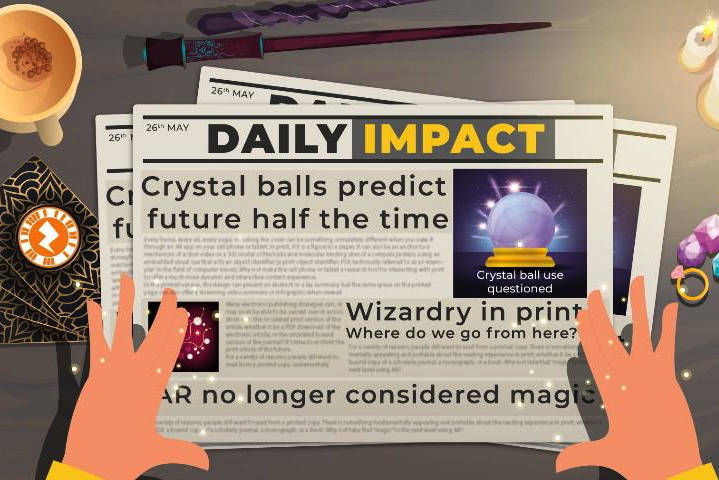Tech focus: Lights, camera, action

Sponsored by

The use of video in academic publishing continues to increase, writes Tim Gillett
Powered by burgeoning computing power, cheaper equipment and ever-more user-friendly video software, the use of video in scholarly communications continues its inexorable rise.
Whether recording the proceedings of industry events, embellishing and expanding e-book content, or bringing the magic of augmented reality to the textbook, humble mobile phones and high-end video cameras have become common currency on the industry circuit. But it seems that, in the greater scheme of things, video in academia is a relatively untapped market.
Violaine Iglesias, of Cadmore Media, which helps organisations to publish scholarly and professional information through streaming video and audio, says that while the higher education world has long embraced streaming – with academic libraries licensing video collections from a handful of specialised providers – the scholarly and professional community has been slow to embrace audio and video.
In a paper written for the NFAIS 2019 Annual Conference, Cadmore explained: ‘Not only is there a lot of untapped archival audiovisual content on hard drives all over the world, but more and more content is being produced every day: recorded events, research outputs, teaching and learning material, best practice videos, professional development courses, public outreach, podcasts.
‘More often than not, this content lives on YouTube, making it impossible to distinguish authoritative content from amateur videos. Who wants their surgeon to “refresh their memory” on how to perform a procedure by watching a YouTube video? Well, at the moment, surgeons do use YouTube for professional purposes. It is not a stretch of the imagination to see a world where practitioners have access to curated, peer-reviewed videos published and vetted by society communities, who undoubtedly include the world’s top experts.’
Cadmore argues that, while media content is a powerful way to communicate certain types of information, it is almost invariably hard to find.
She continues: ‘Once it has been found, the user experience is often unfriendly. Unlike with an article or a book, it is virtually impossible to know what a video or podcast contains without committing to watching or listening to it in its entirety.
‘When it comes to entertainment, that is a perfectly desirable experience; for scholarly information, this can be a fastidious exercise for which most professionals do not have time. The human brain can read much faster than it can listen to someone speak to them. Most of us want the ability to skim a video in the same way that we would a long-form piece of written text.’
She continues: ‘There has not been a solution for publishers to handle video and audio content with the professionalism that has been awarded to digital books and journals for decades. Instead, there have only been mass-market solutions that are designed for large media organisations, but that are missing some key workflow pieces to fully integrate audiovisual material into the scholarly ecosystem, from peer-review to indexing and preservation. In particular, there has not been a good system to manage the collection and delivery of well-structured metadata.’
Cadmore is one of a growing number of companies that are increasingly active in the video space in the scholarly communications industry. JoVE makes and publishes videos of scientific experiments from the top laboratories around the globe, and counts more than 1,000 universities, colleges, hospitals and biotech companies among its clients.
SAGE Publishing is one of several publishers that are regular users of the video format, its streaming collections developed in partnership with leading academics, societies and practitioners to deliver teaching and research-oriented products in the social sciences. Of course, the two commercial supporters of this article, MIT Press and SpringerNature (see below), have their own video products to promote. Even Research Information has embraced the use of video and augmented reality in recent months – there must be something in it!
https://www.jove.com
https://us.sagepub.com/en-us/nam/home
Wingardium leviosa!
This publication has been involved in two recent initiatives involving the use of video. Our one-day event in November, CISPC 2019, prompted the recording of two short films and the launch of our own RI TV channel at https://www.researchinformation.info/ri-tv.
And in October last year we worked in partnership with Editage/Cactus Communications to create publishing wizardry on the pages of our print magazine.
The technology, being developed by Cactus Communications, is remarkably reminiscent of the magical newspaper, the Daily Prophet, that appeared throughout the Harry Potter series of films – but it could have exciting implications in the world of education and academia, and in many other areas of publishing.

Imagine technical drawings that spring into animated life in the pages of medical textbooks or journals, short videos of laboratory processes that might otherwise take thousands of words to explain, or animations that sum up technical features or white papers. To check out the augmented reality magic, download the third-party Zappar app from the Apple App store or Google Play onto your cell phone or tablet, hover over the image above, and check out the wizardry yourself!
MIT Press
Known for iconic design, rigorous scholarship, and creative technology, the MIT Press advances knowledge by publishing significant works celebrated for their intellectual daring. MIT Press Direct features more than 950,000 pages of content from the Press’s distinguished front- and backlist, including new releases and classic titles. Libraries can access the complete collection, with nearly 3,000 e-books and at least 130 titles, plus additional OA monographs added each year, or subject-specific collections.
Springer Nature Video
Introducing Springer Nature Video – Discovery in Motion
Springer Nature Video is a collection of highly educational, peer-reviewed videos created by leading academics, practitioners, and thinkers. Titles take viewers through various demonstrations, case studies and lectures that spark discourse and give a unique chance to see experts at work.
Housed on SpringerLink, our videos also incorporate interactive tools and links to related texts that make our content accessible, discoverable, and capable of supporting a diverse range of needs and interests.
Today’s researchers and students are ever-increasingly accustomed to learning from videos. The Springer Nature Video catalogue answers this demand with well-presented, exclusive content in line with our renowned e-book program. With our first two packages, Clinical Medicine and Professional and Applied Computing, users can add value to scholarly work in numerous ways, including with training (such as surgical training; protocols), teaching materials, lectures, interviews and roundtable discussions.
Find out more, and watch our video examples at www.springernature.com/snvideo






